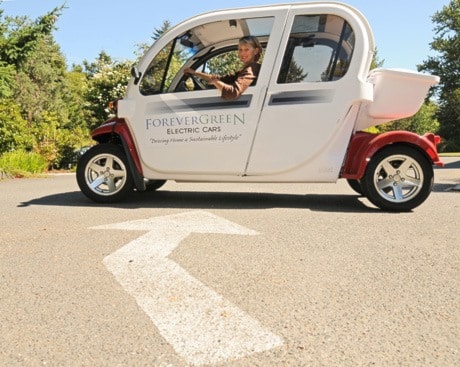Oak Bay councillor Tara Ney is attracting plenty of attention lately. She’s not thumping her chest in council or making big waves politically; no, she’s driving an electric car.
She spotted the little gas saver at the Oak Bay Car Show and spoke to the dealer about taking a test drive. Instead, she got herself a temporary loan of the Global Electric Motorcar (GEM) from ForeverGreen Electric Cars in Parksville. The low speed vehicle has seating for four, hits a top speed of 40 kilometres an hour and goes as far as 48 kilometres on a charge.
“It’s a little putter,” said Ney, describing the vehicle. “It takes me an hour to do a quick errand – everybody is stopping me to ask about it.”
Ney said “people love it,” especially women. “They all say, ‘I want one.’”
What Ney wanted was to get the feel of driving an electric vehicle. She found the small car has advantages as well as disadvantages. “I thought it would help me understand how they work, where the challenges are and what we need to do if we want to (encourage) that kind of car on our roads.”
While the municipality of Oak Bay was the first in the province to allow low speed electric vehicles on its streets – approving them in 2008 – other municipalities are just getting into the trend.
“It’s a challenge. Oak Bay, Esquimalt and Colwood are the initial three that passed a bylaw,” said ForeverGreen sales manager Mark Beuerman.
The city of Victoria passed a bylaw allowing the low speed electric vehicles on its roads in May of 2010 and just renewed the bylaw for two years.
“It would be nice if other municipalities or the CRD would get on board,” said Beuerman. “It would make it easier to get from one place to another.”
While Ney is enjoying the gas-free ride, and getting regular ‘thumbs-up’ from other motorists, she has run into some problems with the little car.
“I have been stuck without a plug-in,” she said. Ney, who works at the University of Victoria, was surprised to find there is nowhere to charge the 110-volt vehicle at the university. “I called BCAA and they didn’t know what to do,” she added. She finally found a plug at a nearby church.
“It speaks to the way we should set electric charging stalls up,” she said, noting larger electric vehicles require 220-volts.
Ney said the reaction she’s receiving is indicative of a desire for alternative transportation in the region.
“People waving and honking says a lot to me. People are waiting for something like this.”
